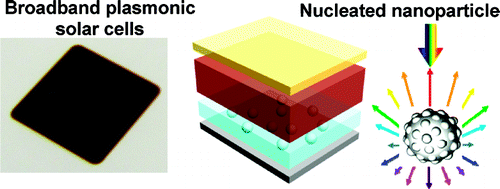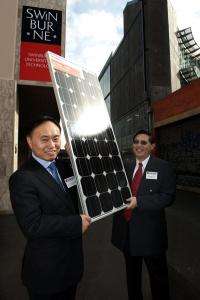World's most efficient nanoplasmonic solar cells developed

(PhysOrg.com) -- In a boon for the local solar industry, a team of researchers from Swinburne University of Technology and Suntech Power Holdings have developed the world’s most efficient broadband nanoplasmonic solar cells.
In a paper published in Nano Letters, the researchers describe how they have manufactured thin film solar cells with an absolute efficiency of 8.1 per cent.
The research was conducted under the auspices of the Victoria-Suntech Advanced Solar Facility (VSASF) at Swinburne. The group is working to dramatically increase the efficiency of thin film solar technology.
According to Swinburne Professor Min Gu, Director of the VSASF, thin film cells have attracted enormous research interest as a cheap alternative to bulk crystalline silicon cells. However, the significantly reduced thickness of their silicon layer makes it more difficult for them to absorb sunlight.
“Light trapping technology is of paramount importance to increase the performance of thin film solar cells and make them competitive with silicon cells,” Professor Gu said. “One of the main potential applications of the technology will be to cover conventional glass, enabling buildings and skyscrapers to be powered entirely by sunlight.”
The VSASF group has been improving thin film cell efficiency by embedding gold and silver nanoparticles into the cells. This increases the wavelength range of the absorbed light, improving the conversion of photons into electrons.

In their most efficient cells yet, the researchers went one step further, using what are known as nucleated or ‘bumpy’ nanoparticles.
Senior Research Fellow at Swinburne Dr Baohua Jia said: “The broadband plasmonic effect is an exciting discovery of the team. It is truly a collaborative outcome between Swinburne and Suntech over the last 12 months.”
Dr Jia believes that this new technology will have an important impact on the solar industry. “What we have found is that nanoparticles that have an uneven surface scatter light even further into a broadband wavelength range. This leads to greater absorption, and therefore improves the cell’s overall efficiency.
Professor Gu applauded the quick timeframe in which the research group has been able to achieve 8.1 per cent total efficiency, however he believes there is still considerable scope to improve the cells and transform the way the world sources energy.
“We are on a rapid upwards trajectory with our research and development. With our current rate of progress we expect to achieve 10 per cent efficiency by mid 2012,” he said. “We are well on track to reach the VSASF’s target to develop solar cells that are twice as efficient and run at half the cost of those currently available.”
Professor Gu said that another advantage of the group’s approach is that nanoparticle integration is inexpensive and easy to upscale and therefore can easily be transferred to the production line.
“We have been using Suntech solar cells from the outset, so it should be very straightforward to integrate the technology into mass manufacturing. We expect these cells to be commercially available by 2017.”
Suntech CEO Dr Zhengrong Shi said: “Our team has achieved an impressive milestone with the world record for the most efficient broadband nanoplasmonic thin-film cell. This is an important step in demonstrating the potential of nanotechnology in leading the next generation of solar cells.”
The Nano Letters paper was authored by Dr Xi Chen, Dr Baohua Jia, Dr Jhantu Saha, Mr Boyuan Cai, Dr Nicholas Stokes, and Professor Min Gu from Swinburne and Dr Qi Qiao, Dr Yongqian Wang and Dr Zhengrong Shi from Suntech.
More information: Paper online: pubs.acs.org/doi/abs/10.1021/nl203463z
Provided by Swinburne University of Technology




















